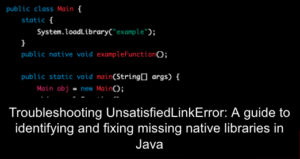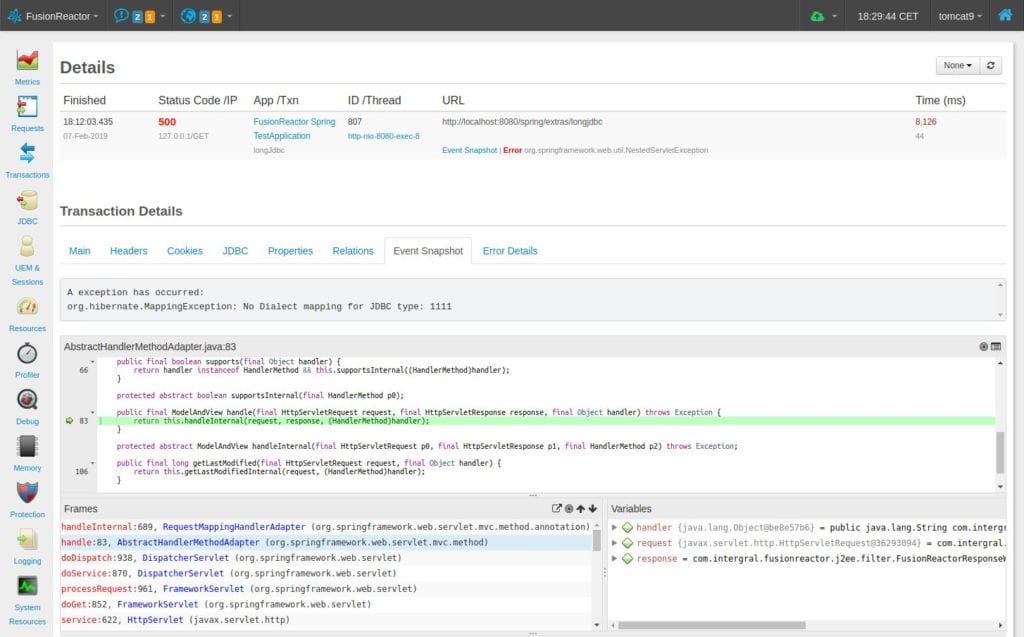IllegalMonitorStateException is a type of error that occurs when a Java program attempts to wait, notify, or notifyAll on an object that it does not own the monitor for. This can happen when a thread attempts to call one of these methods on an object that it has not synchronized on, or when a thread calls one of these methods without first obtaining the lock on the object.
How to avoid an IllegalMonitorStateException in your Java App
One way to avoid this error is to ensure that a thread only calls wait, notify, or notifyAll on an object after it has synchronized on that object. This can be done by using the synchronized keyword or by using a lock to obtain the monitor for the object.
Another way to avoid this error is to use a tool like FindBugs, FusionReactors Event Snapshot, or PMD, which can analyze your code and detect potential IllegalMonitorStateException issues before they occur.
How can APMs like FusionReactor help diagnose an IllegalMonitorStateException?
Application Performance Management, APM tools like FusionReactor can also help identify and diagnose IllegalMonitorStateException issues. FusionReactor provides exception tracking, code profiling, thread dump analysis, performance metrics, and logging features that can help identify the error’s root cause.
For example, Event Snapshot, the exception tracking feature, can track when the error occurs and provide a detailed stack trace that shows which class, method, or line of code caused the error. The code profiling feature can analyze the application’s performance and identify potential issues causing the error.
The thread profiler can provide detailed information about the state of the application’s threads, which can identify which thread is causing the problem and the operation being executed. The performance metrics feature can identify performance bottlenecks contributing to the IllegalMonitorStateException.
The logging monitoring can be used to track the activities of the application, which can help identify when and where the IllegalMonitorStateException occurred.
How do I fix an IllegalMonitorStateException?
Here’s an example of how to use the synchronized keyword to fix an IllegalMonitorStateException:
public class MyClass {
private Object lock = new Object();
public void myMethod() {
synchronized (lock) {
// code that calls wait, notify, or notifyAll
}
}
}
In this example, the myMethod() method is synchronized on the lock object. This means that only one thread can execute the code inside the synchronized block at a time. By synchronizing on the lock object, we ensure that the thread that calls wait, notify, or notifyAll is the one that currently owns the monitor for the object.
Another way to fix this error is by using a lock to obtain the monitor for the object. Here’s an example of how to use a lock to fix an IllegalMonitorStateException:
public class MyClass {
private final Lock lock = new ReentrantLock();
public void myMethod() {
lock.lock();
try {
// code that calls wait, notify, or notifyAll
} finally {
lock.unlock();
}
}
}
In this example, the myMethod() method uses a lock to obtain the monitor for the object. The lock is acquired before the code that calls wait, notify, or notifyAll is executed and is released after the code has been executed, using the try-finally block. This ensures that the thread that calls wait, notify, or notifyAll is the one that currently owns the monitor for the object.
In addition to these code-level fixes, it’s important to remember that issues can also cause IllegalMonitorStateException in other application areas, such as in the application’s configuration or external dependencies. In these cases, using an APM tool like FusionReactor can be extremely helpful in identifying the root cause of the error and providing the necessary insights to fix it.
Conclusion – IllegalMonitorStateException: Understanding, Avoiding, and Fixing
To sum up, IllegalMonitorStateException is an error that occurs when a Java program attempts to wait, notify, or notifyAll on an object it does not own the monitor for. To avoid this error, it is important to ensure that a thread only calls wait, notify, or notifyAll on an object after it has synchronized on that object. An APM tool like FusionReactor can also be useful in identifying and diagnosing IllegalMonitorStateException issues. The exception tracking, code profiling, thread dump analysis, performance metrics, and logging features that FusionReactor provides can help to identify the root cause of the error and fix it.





